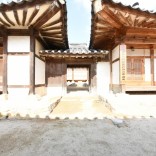Photos
Symbol and pride of Sachon Village, Single-Clan Village of Andong Kim Clan
Manchwidang House, standing upright at the center of Sachon Village, is the symbol and pride of of Sachon Village, Single-Clan Village of Andong Kim Clan. The house is built by Goje Buhogun, Kim Sawon who is the great-grandson of Songeun Kim Gwangsu, the disciple of Toegye, for the purpose of study and training students. The name Manchwidang came from his pseudonym Manchwi, which is from the tree named Mannyeonsong and the poem “Mannyeonsongjeongsi” that his great-grandfather loved. Construction of the house began in 1582(15th year of King Seonjo) and finished in October 1584(17th year of King Seonjo), prior to the Japanese invasion of Korea.
One of the most important buildings with wooden structure constructed before the Japanese invasion of Korea.
The house has 11 rooms and a Daecheong(hall) as the typical Joseon Dynasty’s building. And it is a private house with wooden architecture, the next oldest after Geungnakjeon Shrine at Bongjeongsa Temple in Andong, and Muryangsujeon Shrine at Buseoksa Temple in Yeongju. It also demonstrates the construction style before the Japanese invasion of Korea. It shows high-quality decoration techniques that were rare in private house buildings. Fortunately, the building survived without fire during many historic crises such as the Japanese invasion of Korea, the Second Manchu invasion, the Byeongsin war and the Korean war. Also, the building is a unique Confucian architecture well preserved without deconstruction or reconstruction. It is said that the signboard is written by Seokbong Han Ho. The structure was very simple at first, having floor and balustrade only, but an extended building “Bokje” with two rooms became the east wing of the house in 1727(3rd year of King Yeongjo) and then the west wing with one room was added, while replacing ridge poles and roof tiles in 1764(40th year of King Yeongjo), establishing the shape of present.
Gyeongsangbuk-do Tangible Cultural Heritage No. 169
The house was repaired several times, and walls were built in 1980. When it was designated as the Gyeongsangbuk-do Tangible Cultural Heritage No. 169, Uiseong-gun authority remodeled it by replacing rafters and roof tiles and added Dancheong, the traditional paintwork. Manchwidang was originally open type without wall and gate, but at this time a lattice gate and a wooden gate were added to the south and west of the building at that time. And the northern rafters are removed and a floor is added. Steppingstone on the entrance step is made of the blue stone from neighboring village Oksan. In 1996, all the roof tiles are replaced by Goryeong roof tiles, and in 2005 the wall has been rebuilt.
[Gyeongsangbuk-do Tangible Cultural Heritage No. 169/ State-designated Cultural Heritage Treasure No. 1825 (designated in 5th June 2014)]







